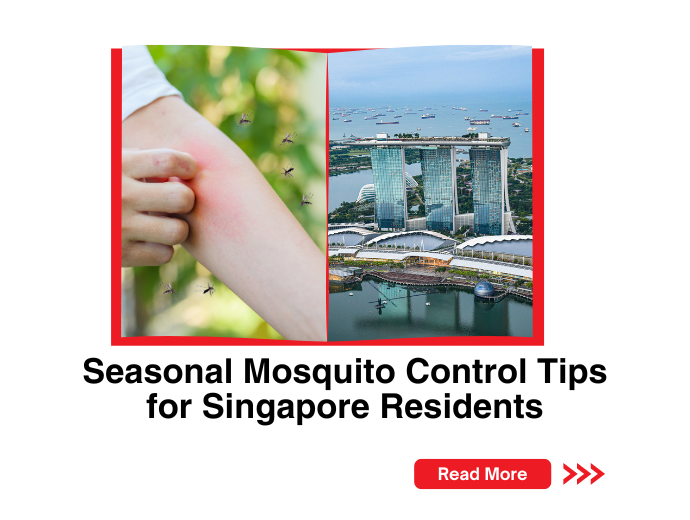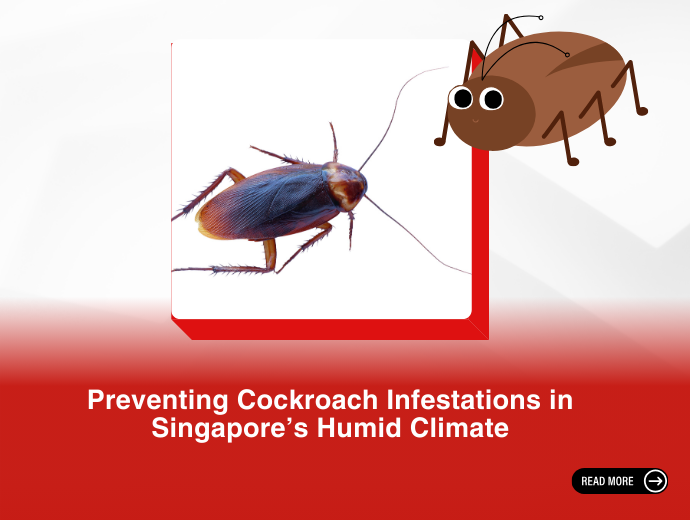Singapore is invaded by mosquitoes all year round. The country’s tropical climate with consistent temperature and high humidity creates an ideal breeding ground for these pests. Besides the buzzing nuisance and itchy bites, they carry diseases like chikungunya, Zika virus, and dengue fever. Therefore, Singaporeans must exercise effective mosquito control, especially as seasons change. Through this blog, we will explore tailored tips to tackle seasonal mosquitoes in our island’s unique climate.
An insight into Singapore’s season and mosquito pattern
Understanding the seasonal variation is crucial for implementing effective mosquito control strategies and curbing their population.
Singapore experiences two distinct seasons: wet and dry. The Northeast Monsoon causes the wet season that ranges from November to January. These months witness high humidity, heavy rainfall, and intense thunderstorms. Stagnant water and puddles are everywhere, creating ideal mosquito breeding sites. Conversely, the Southwest Monsoon drives the dry season from May to September. It is marked by lesser rainfall and higher temperatures with significant humidity levels. This season also has mosquito problems, as breeding can still occur in neglected or stored water containers.
Expert tips for seasonal mosquito control in Singapore
1. Eliminate breeding grounds
Keep a check on any stagnant water sources around your residence. The following steps can help you prevent mosquito breeding.
Follow NEA’s 5-step Mozzie Wipeout BLOCK:
- Break the hardened soil in your pots
- Lift and empty the stagnant water from flower pot plates
- Overturn pails or other water containers and wipe the rim
- Change the water regularly in the vases or flower bowls
- Keep the leaves and debris away from roof gutters. Place Bifenthrin (BTI) insecticide
Indulge in weekly inspections to remove any standing water, such as:
- Discarded tyres or containers
- Empty cans, barrels, or tanks
- Potted plant trays
- Bamboo pole holders
- Drains or gully traps (Cover them with wire mesh or tight-fitting lid)
2. Maintain your Surroundings
Keeping your surroundings well-maintained, especially during the wet season, can significantly help in mosquito control:
Trim Vegetation
Mosquitoes thrive in areas with dense greenery, such as potted plants, garden patches, and areas around building with some landscaping. Regularly trimming plants, clearing overgrown areas, and maintaining a neat landscape can reduce mosquito breeding grounds.
Clear debris
Remove any fallen leaves, flower petals, and other debris from outdoor areas, such as balconies, courtyards, or common corridors. These materials can trap moisture, creating potential breeding sites for mosquitoes. Regular cleaning is key to preventing stagnant water accumulation.
3. Use repellents
With the constant influx of mosquitoes in both wet and dry seasons, repellents can deter them providing some protection and relief. However, you must note that their effectiveness is limited!
- Repellents like balms, roll-ons, sprays, patches, and lotions can be applied to exposed skin or clothing.
- Plant peppermint, citronella, or lemongrass around your garden or patio areas.
- Use candles, coils, essential oils, killer lamps, liquid vapouriser, ultrasonic insect repellent, or diffusers to repel mozzies!
Call for a professional pest control service provider
While the above tips can marginally help you tackle mozzie woes, only professional exterminators can help you address and eliminate them in both seasons effectively:
Source reduction:- One of the most effective methods to eliminate breeding sites is checking and removing all sources of problem-causing stagnant water.
Adulticiding:- Adulticiding is a targeted approach used to control adult mosquitoes, the ones responsible for biting and spreading diseases. It involves applying insecticides through ground or aerial spraying to quickly reduce mosquito populations in high-risk areas. This method is especially effective for immediate control, helping to break the transmission of diseases like dengue, Zika, and malaria. However, adulticiding works best when combined with other long-term strategies, like larviciding and habitat management, to ensure comprehensive mosquito control.
Larviciding:- Larviciding is a critical mosquito control strategy that focuses on eliminating mosquito larvae before they can mature into adult mosquitoes, which are responsible for spreading diseases such as dengue, malaria, and Zika. The process involves applying larvicides to water bodies where mosquitoes lay their eggs, such as stagnant ponds, drains, and containers. By targeting larvae in their aquatic stage, larviciding interrupts the mosquito life cycle early on, significantly reducing the adult population. This proactive approach is vital for long-term mosquito control, especially in areas where mosquitoes breed rapidly.
There are several types of larvicides, each with a specific mode of action designed to disrupt mosquito development. Insect Growth Regulators (IGRs), such as methoprene and pyriproxyfen, mimic juvenile hormones in mosquitoes, preventing larvae from maturing into adults. These IGRs effectively disrupt the normal development process without harming non-target organisms, making them a preferred choice in integrated pest management programs.
Oils and surface films are another form of larviciding. These agents create a thin film on the water's surface, suffocating mosquito larvae and pupae by blocking their access to air. This method is particularly useful for controlling mosquito populations in larger water bodies where larvae are present in significant numbers.
Biological larvicides, such as Bacillus thuringiensis israelensis (Bti), offer a more environmentally friendly approach. Bti is a naturally occurring bacterium that produces toxins targeting mosquito larvae. When ingested, these toxins damage the gut lining of the larvae, causing them to die. One of the major advantages of Bti is its high specificity—it only affects mosquitoes, blackflies, and certain midges, while being harmless to humans, pets, fish, and other wildlife. This makes Bti an excellent option for use in ecologically sensitive areas where minimizing impact on non-target species is essential.
Larvicides come in various formulations to suit different environments and application needs. Liquid formulations are often used for immediate impact over large water areas, ensuring quick distribution. Granules and pellets are slow-release options that sink into the water, offering long-lasting control in stagnant or semi-permanent water bodies. For smaller water sources like ponds, fountains, or gutters, briquettes or tablets are commonly used, as they slowly dissolve over time, providing weeks or even months of protection. Water-dispersible powders spread quickly in areas with low water flow, making them effective for specific breeding hotspots.
Incorporating larviciding into an integrated mosquito management plan provides a more effective solution than relying on adulticiding alone. By targeting mosquitoes at the larval stage, you prevent them from reaching the adult, disease-transmitting phase, reducing the overall mosquito population. With a variety of larvicides and formulations available, larviciding can be adapted to suit different environments and needs, making it an essential part of any comprehensive mosquito control strategy.
At ORIGIN we excel at source reduction, fogging, and larviciding for eliminating these pests. But we take pride in our data-driven mosquito treatment called the 3+1 Mosquito Management Programme. In this solution, our trained technicians inspect your premises, install the innovative ORItrap, carry out dual misting, and monitor hot spots or potential breeding sites through data and software. Data collected overtime enables proactive measures and preempts seasonal trends about mosquito.
Singapore Government's Adoption of the Wolbachia Technique
In Singapore, The National Environmental Agency (NEA) has adopted the innovative Wolbachia technique as part of its mosquito control strategy to combat diseases like dengue, Zika, and chikungunya. Wolbachia is a naturally occurring bacterium found in many insects but not in Aedes aegypti, the primary mosquito responsible for transmitting these diseases. The technique involves releasing male Aedes aegypti mosquitoes infected with Wolbachia. These males do not bite or spread diseases, but when they mate with wild females, the resulting eggs do not hatch, significantly reducing the mosquito population over time. This method is highly targeted, environmentally friendly, and sustainable.
The Wolbachia-Incompatible Insect Technique (IIT) has shown promising results in Singapore. Field trials conducted by the National Environment Agency (NEA) in areas like Yishun and Tampines resulted in up to a 98% reduction in the Aedes aegypti mosquito population. This proactive approach reduces the risk of disease transmission without relying on chemical insecticides, making it a safer, long-term solution.
However, the Wolbachia technique has some drawbacks. One limitation is its localized nature. For the method to be effective, large numbers of Wolbachia-infected males must be released regularly and in targeted areas. If certain breeding sites are missed, or if the area is too large for consistent coverage, the results may not be as impactful. Additionally, the technique takes time to show results, as it requires multiple mating cycles to reduce the population. Unlike chemical insecticides that offer immediate effects, Wolbachia works more gradually, making it less suitable for sudden, large-scale outbreaks.
Additionally, Wolbachia only targets Aedes aegypti, which transmits dengue, but not other species like Aedes albopictus or Culex mosquitoes that carry diseases such as Japanese encephalitis or West Nile virus. This means the Wolbachia technique should be part of a broader, integrated mosquito control strategy that includes other methods like larviciding and adulticiding.
Despite these limitations, the Wolbachia technique is an innovative tool in Singapore’s fight against mosquito-borne diseases. Its targeted approach, combined with traditional methods, is helping reduce mosquito populations and the spread of diseases in a sustainable and eco-friendly way.
Summing up
While the Singapore government is pulling out all the stops—using Wolbachia and other high-tech methods to combat mosquitoes—let's not forget that we all have a part to play. Think of it as a team effort: they handle the science, and you handle the simple stuff like tipping out that stagnant water in the plant pot or making sure your gutters aren’t turning into mosquito spas. And yes, checking for sneaky water puddles around the house might not be glamorous, but it's better than becoming a mosquito buffet!
But let’s be honest, sometimes these pests still find a way to crash the party. If you’re starting to feel outnumbered, it’s time to bring in the big guns. Call ORIGIN Exterminators and let the pros take over—because while you’ve got the mosquito-checking covered, they’ve got the serious tools to keep your home mosquito-free. Don’t wait for the buzz to get louder—contact ORIGIN today!




.png)
